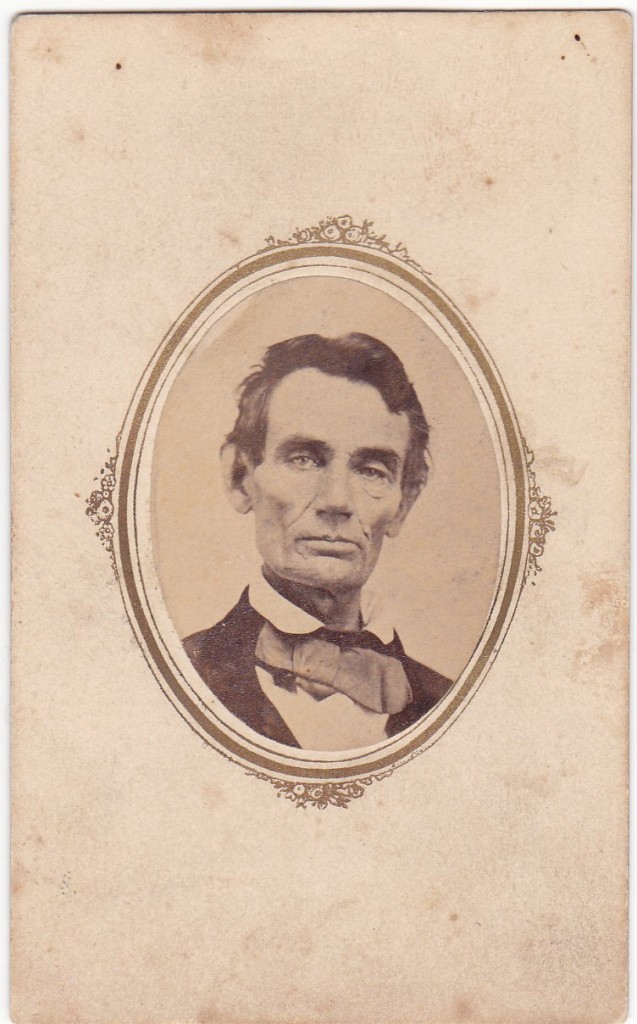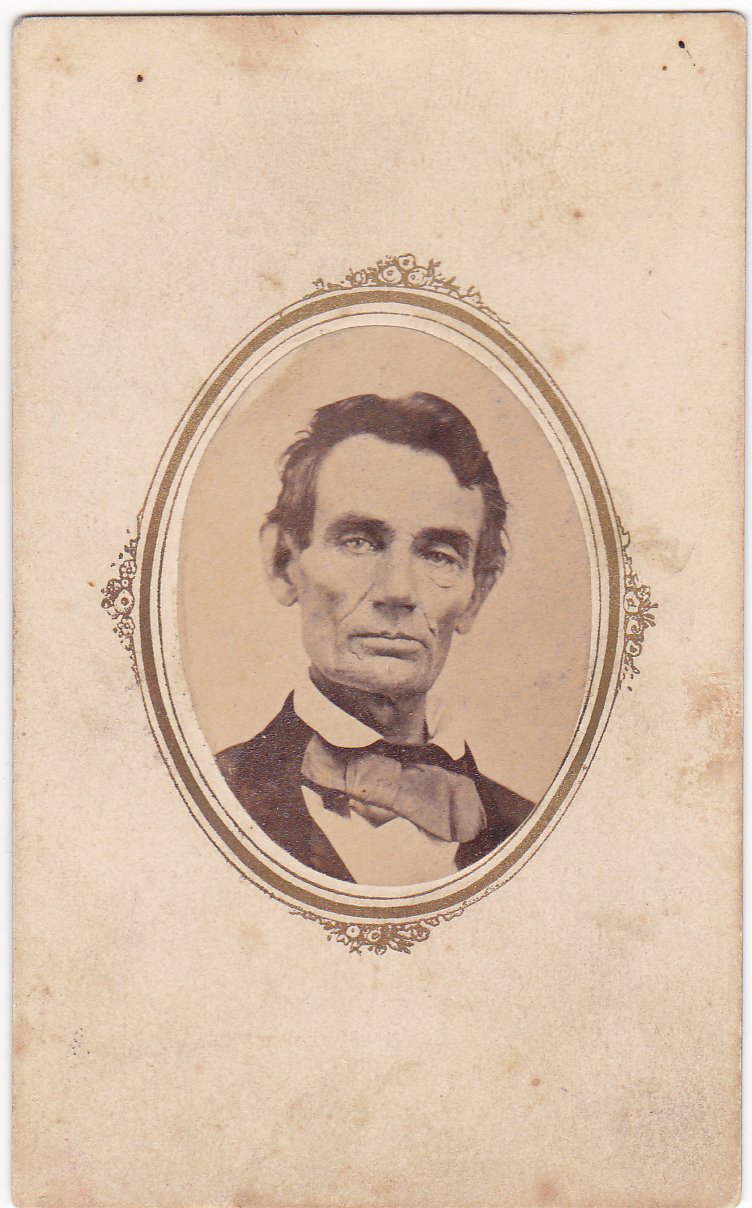
This Western Illinois Museum artifact is a photographic print of the 1858 ambrotype of Abraham Lincoln taken by Macomb photographer William Painter Pearson. Pearson’s name has also appeared as W.P., T.P. Pearson, Pierson, or Tom Pearson. The print was donated to the Western Illinois Museum in 2013 by Frances Smith.
Ambrotypes were made on a glass plate coated with a wet, light-sensitive substance, which, when developed and dried, produced a negative image. “The negative” then had to be mounted against a dark background or coated with a dark varnish to give the illusion of “a positive.” Ambrotypes became very popular in the mid-1850s and were much less expensive to produce than daguerreotypes, which were images on a silver-coated copper plate. Like daguerreotypes, ambrotypes are unique objects. Ambrotypes were popular for only about ten years. During the 1860s, ambrotypes were replaced by the tintype, a photograph made on thin black-lacquered iron, and photographs printed on paper.
The photographer, Pearson, was born in 1833 in Centerville, Butler County, Pennsylvania. In 1849, his widowed mother moved the family to Illinois, and they settled on a farm near LaHarpe. By 1858, the family had moved to Macomb, where Pearson established his photography studio. The studio was on the second floor of a building on the southeast corner of the Courthouse Square, where now stands the Citizens Bank.
Pearson is known in McDonough County history as the only photographer in Macomb to take Lincoln’s portrait. Not much else is known about Pearson’s life except what can be gathered from public records. Some personal information about Pearson is in the Illinois Civil War Muster and Descriptive Rolls. The Rolls list that Pearson was 29 years old when he joined up on June 18, 1862. The Muster notes that Pearson was five feet, eight and a half inches tall with black hair. He listed that he was married and his occupation was artist. He became a second lieutenant in Company C, 84th IL US Infantry. For an unknown reason, he resigned on February 22, 1863. Pearson died on December 1864 in a tragic accident at the age of 31. While riding in a funeral procession, he was fatally injured by a team of runaway horses when a carriage overturned. He is buried in Oakwood Cemetery, Macomb.
The photograph taken of Lincoln in Macomb was taken during the seven debates he had with Stephen Douglas in 1858, sometimes referred to as the Great Debates of 1858. Lincoln and Douglas were seeking election to the Senate, and at the time, U.S. senators were elected by state legislatures. The debates were designed to allow the candidates to be heard in the state’s congressional districts. Even by modern standards, the extensive travel and speaking both Lincoln and Douglas undertook are impressive. His itinerary from the first debate to the second debate looks exhausting.
August 21: Lincoln arrives in Ottawa for the first debate and debates Douglas in front of 12,000 people
August 22: Lincoln stays in Ottawa
August 23: Lincoln takes a 3:00 am train from Ottawa and travels to Henry, where he addresses a meeting of citizens
August 24: Lincoln, on the train to Augusta, stops in Galesburg at 3:30 pm i and speaks to about 1,000 people. James K. Magie meets him at the train station and travels with Lincoln onwards to Augusta.
August 25: Lincoln is in Augusta and speaks at about 2:00 pm in a grove of trees outside of town to a crowd of 1,200 people in the rain. Because there are not adequate accommodations in Augusta. Lincoln gets back on the train and travels to Macomb to spend the night. When he reaches Macomb in the evening, Lincoln speaks at the McDonough County courthouse and then retires to the Randolph House, which was, at that time, a large, luxurious hotel.
August 26: Lincoln walks around the Macomb Square and is persuaded by James K. Magie to have his photograph taken. Lincoln at Pearson’s studio was reportedly with William Randolph of Macomb, Silas Hopper of Blandinsville, and Joseph MeDill, editor of the Chicago Tribune. The Pearson photography studio was right across the street from the Randolph House hotel. After the photograph is taken, Lincoln then boards the train at the Macomb station, and in the afternoon, he arrives in Amboy, where he gives a short speech and stays the night.
August 27: Lincoln arrives in Freeport and debates Douglas for the second time.
James K. Magie was the person who convinced Lincoln to get his picture taken in Macomb so that [Magie] could have an image of Lincoln. In 1858, Magie was the editor of the Oquawka Plaindealer newspaper and was involved in state politics. He became intensely interested in Lincoln and wanted to hear Lincoln speak. In the August 9, 1891 issue of the Chicago Tribune, Magie recalls how he came to be with Lincoln in Macomb.
[Lincoln’s] first joint debate with Mr. Douglas occurred at Ottawa, Aug. 21, 1858. It was about 150 miles from my home, but my enthusiasm for the man was now at fever heat, and I joined the crowd which listened to that first of the great debates between these intellectual giants. It was held in a convenient grove adjoining the town. There were 20,000 people at that great meeting. At the close of this first debate I had the good fortune to meet Mr. Lincoln at the house of a citizen, and he took some interest in me when he found that it was my intention to be present at his next appointment on the following Wednesday at Augusta, Hancock County on the occasion of a Congressional convention in my district at which I had been appointed a delegate. He was not very well acquainted with the railroads of that section, and he desired me to map out his route, which I did. According to [the] appointment, I met him and Joseph Medill, the editor of the Chicago Tribune, at Galesburg the following Tuesday. Augusta was a village on the line between Galesburg and Quincy. We started for Augusta about 3 p.m., and on the train, the question was raised as to the hotel accommodations of the town, and learning from the conductor that they were rather poor, we concluded to stop off at Macomb. A new hotel of ample dimensions had been recently completed at this place.
The same photographic print of the Macomb ambrotype is in the collection of the Lincoln Home National Historic Site in Springfield. On the back of the Lincoln Home print is the following inscription, which supports Magie’s recollection:
From a photograph loaned by W. J. Franklin of Macomb, Illinois, and taken in 1866 from an ambrotype made in 1858 in Macomb.
“This likeness of Abraham Lincoln is a faithful copy of an original ambrotype, now in possession of James K. Magic [Magie]. It was taken August 25, 1858, by Mr. T. P. Pierson, [sic] at Macomb, in this State, and is believed to be of anterior date to any other likeness of Mr. Lincoln ever brought before the public.”
Mr. Magie happened to remain overnight at Macomb, at the same hotel with Mr. Lincoln, and the next morning took a walk about town, and upon Mr. Magie’s invitation, they stepped into Mr. Pierson’s establishment, and the ambrotype of which this is a copy was the result.
Mr. Lincoln, upon entering, looked at the camera as though he was unfamiliar with such an instrument, and then remarked: “Well, do you want to take a shot at me with that thing?” He was shown to a glass [mirror], where he was told to “fix up,” but declined, saying it would not be much of a likeness if he fixed up any. The old neighbors and acquaintances of Mr. Lincoln in Illinois, upon seeing this picture, are apt to exclaim: “There! that’s the best likeness of Mr. Lincoln that I ever saw!” The dress he wore in this picture is the same one in which he made his famous canvas with Senator Douglas.”
This inscription was written by J. C. Power, who, now dead, was custodian of the Lincoln monument in Springfield.
From page 65 of The Early Life of Abraham Lincoln, by Ida M. Tarbell and J. McCan Davis, New York: S.S. McClure, 1896.
“At some point in time, the Pearson ambrotype was sold to Richard Watson Gilder, editor of the Century Magazine, published in New York City. Gilder had a great interest in Lincoln and kept the ambrotype at his office in the Century Magazine building. In 1888, the building suffered a disastrous fire[,] and the ambrotype was destroyed. Luckily, a photographic print of the ambrotype had been made in 1866. W.J. Franklin of Macomb owned the 1866 photographic print of the ambrotype. The museum image is a print of the 1866 print of the 1858 ambrotype.”
Lincoln visited Macomb two other times besides his August visit when he was photographed. Lincoln’s second visit to Macomb was only a stopover on October 12. Lincoln’s third visit to Macomb was on October 25, when he spoke in the Courthouse Square to nearly 4,000 people. Mounted on the southwest corner of the McDonough County Courthouse is an engraved plaque marking the spot where Lincoln addressed the crowd.
